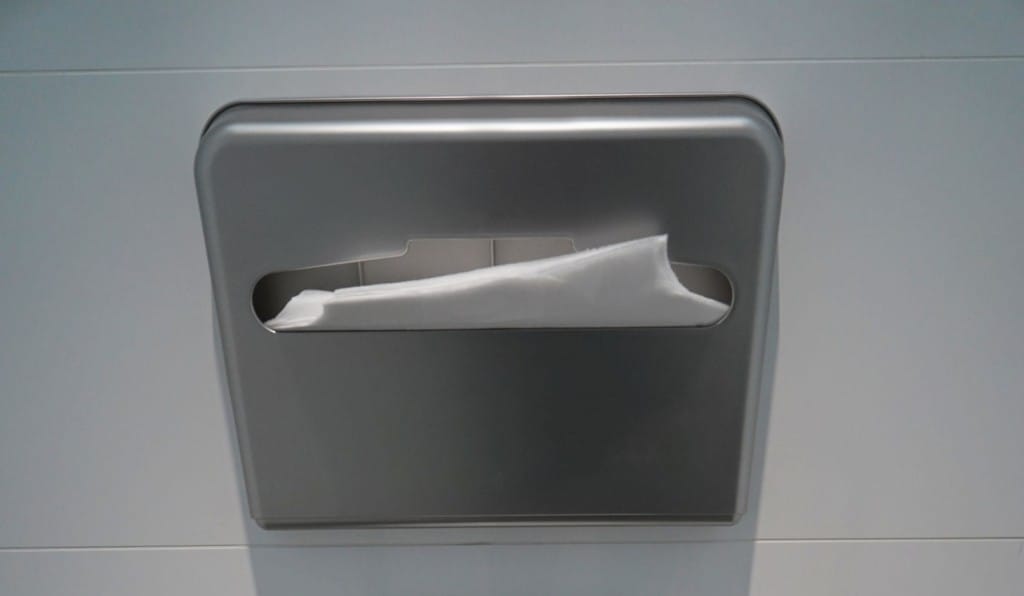
There’s a moment of pause. You’re in the bathroom. You see the toilet seat cover, and I thought pops into your head: Are toilet seat covers flushable?
Most toilet seat covers are flushable, including the paper toilet seat covers commonly provided in public restrooms. However, decorative toilet covers, like cotton or faux fur styles, are not flushable.
In addition, even though you can flush most paper toilet seat covers, you may not want to if the toilet has weak plumbing, or if it’s connected to a rural septic system. Below we’ll dive into more detail on if/when you can flush toilet seat covers.
Disclaimer: This post contains affiliate links. This means I may earn a commission should you choose to make a purchase using my link
Table of Contents
Are Toilet Seat Covers Flushable?
“Toilet seat cover” isn’t specific enough to answer with just one simple answer. As mentioned before, there are paper toilet seat covers that are flushable, but there are some that would have you calling a plumber if you flushed them down the toilet.
Paper toilet seat covers are used to protect you from touching any bacteria left on the toilet seat by the people before you. They are sometimes provided in public restrooms, but some people may bring their own just in case there aren’t any provided.
Though paper toilet seat covers can be broken down at a commercial waste treatment plant, they cannot break down everywhere. If you have a house with a septic system, paper toilet seat covers may not break down in the tank.
You want to make sure you do everything you can to not clog the septic tank. You can do this by using septic-safe toilet paper, which tends to dissolve well in water. If you do use paper toilet seat covers, you need to be careful to use only toilet seat covers that will break down in the septic system.
A septic system simply spreads the waste throughout a septic field. It does not have industrial facilities like a town or city to help break things down, including some things labeled as ‘flushable’.
It’s not just septic systems to be careful of, either. In older buildings, sewer piping or building drains may not be as clear and free-flowing and could clog if something large is flushed. This is also common in scenarios where the toilet is a gravity flush toilet or it is being sent into a septic tank.
If you commonly use paper toilet seat covers, make sure you know what kind of area you’re in. If the waste water goes into a large wastewater treatment facility, then the toilet seat covers will break down. But, if it’s a small system and you’re not sure, then throw them away in the trash just for good measure.
We’ve mentioned a few different kinds of toilet seat covers, so let’s go over each one.
Types of Toilet Seat Covers
It is important to know the difference in the types of toilet seat covers so you’re not put in a situation where you have to pay for a plumber.
Flushable toilet seat covers are typically single-use while nonflushable ones stay on your toilet seat for a while and are usually washable.
Below are a few examples of toilet seat covers. I’ve labeled two as “flushable” and two as “non-flushable” so you can see the differences between the two.
| Product | Type | Link |
| Discreet Seat 1000 Pack Toilet Seat Covers | Flushable | Click HERE |
| Evealyn Toilet Seat Cover | Non-flushable | Click HERE |
| 24 Large Disposable Toilet Seat Covers | Flushable | Click HERE |
| 5-pc Soft Warm Cloth Toilet Seat Covers | Non-flushable | Click HERE |
What Is the Correct Way to Use Toilet Seat Covers?
Many people want to use a toilet seat cover but don’t know how. They aren’t common everywhere so when you go travel, you may see one and wonder how to use it. Below is a video that shows the proper way to use it:
If you’re like me, you’ll notice right away that you’ve been putting the cover on backward! Well, now we know.
If you don’t like watching videos, here’s a summary of what to do:
In most public restrooms, there is a dispenser above the toilet that provides you with a toilet seat cover. Once you pull the cover out of the dispenser, you need to unfold it and look for the flap in the middle.
That flap will sit in the water while you use the toilet.
Make sure the flap is on the front side of the toilet (e.g. the side in front of you when you’re sitting). The flap should be hanging from the cover, and touching down to the water below.
That way, once you get done using the toilet, all you need to do is flush and the toilet seat cover will go with it because of the flap. That’s good news because you can avoid touching the toilet seat after you’ve used it.
Here are some more tips for using a toilet seat cover:
- Make sure there aren’t any visible holes in the toilet seat cover. If you were to sit on the toilet seat cover with holes in it, that would defeat the purpose of it.
- Be sure that the toilet seat cover covers the entire toilet seat to avoid your skin touching the toilet seat.
- Be sure that there aren’t any big droplets on the toilet seat. Though you have a toilet seat cover separating you from the seat, a very thin paper is not going to protect you from liquids very well. It will just get damp and fall apart.
Are Toilet Seat Covers Bad for the Environment?
Even though many believe toilet seat covers are completely safe for themselves and the environment, there is evidence that shows they are bad for the environment.
While a lot of the flushable toilet seat covers are made of paper, there are some that are made of plastic. Plastic is infamous for being bad for the environment. Though plastic toilet seat covers are more durable and will do better are protecting you from germs, they actually do more harm than good.
The plastic in the toilet seat covers can contaminate the soil and water surrounding it underground. The plastic and its chemicals will seep into the ground, causing harm to the Earth.
If you ever decide to use flushable toilet seat covers, be sure to make sure they are not made of plastic.
Do Toilet Seat Covers Do Anything?
There are some convincing studies that claim toilet seat covers aren’t that useful when protecting us from bacteria on a toilet seat.
In fact, there isn’t anything dangerous on a toilet seat that we need protection from. According to Dr. William Schaffner, a professor of preventive medicine at Vanderbilt University Medical Center, ”Toilet seats are not a vehicle for the transmission of any infectious agents — you won’t catch anything,”
To be fair, there may be a rare case where there may be dangerous bacteria on the surface of the toilet seat. However, in cases like those, your skin acts as a barrier that fights off bacteria unless you have an open wound that the bacteria can reach.
While on the topic of bacteria, it is important to know that there are so many other things you come in contact with every day that have more bacteria than toilets. In fact, a toilets’ smooth surface is made to prevent bacteria from being able to latch on.
In addition, toilet seats do not stay warm enough for transmittable diseases to stay alive. Therefore, many worries concerning public toilet seats aren’t completely necessary.
If you are going to take precautions when in contact with toilet seats, then it is important to take precautions with any other objects that are prone to have more bacteria like refrigerators, TV remotes, and money.
All that being said, there’s nothing wrong with using toilet seat covers just in case. Just make sure they aren’t made of plastic and be considerate of the septic system in use.
In Conclusion
Paper toilet seat covers are usually flushable, but it is important to make sure that you aren’t flushing any other non-flushable or decorative toilet seat covers.
There are a lot of misconceptions about toilet seat covers out there, so if and when you use one, use it in an educated way.
With all that information about toilet seat covers under your belt, get out there and make some little upgrades to your life.
